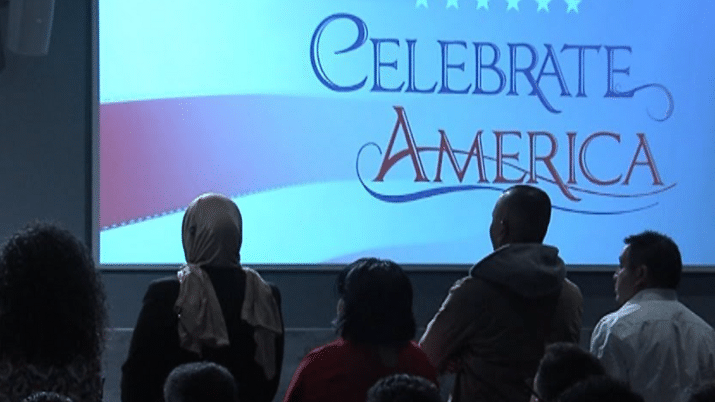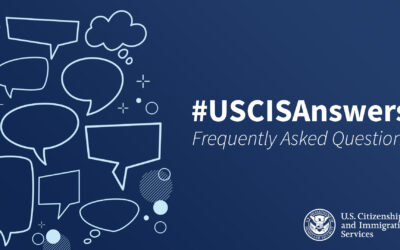June is an important month as President Trump decides to continue or modify immigration suspension, and the U.S. Supreme Court determines the future of DACA program. Certain Chinese students and researchers will have less presence on American campus from now on.

Citizenship ceremony at Metropolitan Community College in Omaha, Nebraska in April 2019.
In the last six months, President Donald Trump has signed seven proclamations aimed at barring or limiting immigrants and nonimmigrants from entering the United States.
Most of the proclamations are associated with health concerns from the COVID-19 pandemic and attempts to curb the spread in America. Another involves protecting the domestic labor market during the economic downturn by eliminating competition from new immigrants. The last involves Chinese students and researchers who are perceived as a threat to national security.
Each of the five proclamations pertaining to COVID-19 were signed at different times as each country or region was identified with virus outbreaks. People traveling through or from those regions are seen as posing a risk, potentially carrying the virus and spreading it in the United States.
China
On Jan. 31st, the first proclamation was signed, impacting people traveling through and from China.
“The potential for widespread transmission of a novel (new) coronavirus … by infected individuals seeking to enter the United States threatens the security of our transportation system and infrastructure and the national security,” the proclamation reads.
“Because the outbreak of the virus was … centered in the People’s Republic of China, I suspended and limited the entry of all aliens who were physically present within the People’s Republic of China, excluding the Special Administrative Regions of Hong Kong and Macau, during the 14-day period preceding their entry or attempted entry into the United States, subject to certain exceptions.”
Included in the lengthy list of exceptions are permanent U.S. residents; alien spouses; minor siblings, parents or legal guardians of a minor U.S. citizen or lawful resident; and any alien child, foster child or ward of a U.S. citizen or resident, or who is a prospective adoptee.
The proclamation remains in effect until terminated by Trump. The Secretary of Health and Human Services will make recommendations to the president to continue, modify, or terminate the proclamation.
Iran
On Feb. 29th, Trump signed a second similar proclamation impacting people traveling through and from Iran.
“Iran is not a trustworthy state actor, as it has repeatedly demonstrated through its history of engaging in malign activity, and confirmed most recently by its repeated denials of responsibility for shooting down an international airliner,” the proclamation reads. “The United States Government is therefore unable to rely on official information disseminated by Iran, undermining the effective evaluation and monitoring of travelers continuing to arrive from that country.”
Europe (Schengen Region)
On March 11th, travel was restricted or banned from the 26 European countries in the Schengen area. Using the same concerns about COVID-19, the proclamation impacted people traveling through or from Austria, Belgium, Czech Republic, Denmark, Estonia, Finland, France, Germany, Greece, Hungary, Iceland, Italy, Latvia, Liechtenstein, Lithuania, Luxembourg, Malta, Netherlands, Norway, Poland, Portugal, Slovakia, Slovenia, Spain, Sweden, and Switzerland.
“The United States Government is unable to effectively evaluate and monitor all of the travelers continuing to arrive from the Schengen Area,” the proclamation reads.
While restricting travel from this region, Trump emphasizes in the proclamation that “the free flow of commerce between the United States and the Schengen Area countries remains an economic priority for the United States, and I remain committed to facilitating trade between our nations.”
England and Ireland
On March 14th, three days later, a similar proclamation was signed impacting travel through or from England and Ireland.
Brazil
On May 24th, the latest COVID-19 proclamation was signed involving Brazil.
Pausing Immigration
At the same time Trump was signing proclamations aimed at curbing COVID-19 infections, he also moved to ban or limit all immigrant entry into the United States to prevent growth in the size of the labor force as unemployment soared.
The proclamation, signed April 22nd by Trump, suspends entry of immigrants who pose a risk to the labor market during the country’s recovery. This suspension is in effect for 60 days, meaning it will be reviewed for possible amendments or extension by late June. The Secretary of Homeland Security, the Secretary of State and the Secretary of Labor will recommend whether to continue or modify this proclamation.
“I have determined that, without intervention, the United States faces a potentially protracted economic recovery with persistently high unemployment, if labor supply outpaces labor demand,” Trump states in the proclamation. “Excess labor supply … is particularly harmful to workers at the margin between employment and unemployment, who are typically ‘last in’ during an economic expansion and ‘first out’ during an economic contraction.”
Workers at the margin are identified as historically disadvantaged groups, including African Americans and other minorities, people without a college degree, and people with disabilities.
With the intention of helping these workers recover from unemployment caused by the COVID-19 slowdown, the Trump administration’s move is to eliminate competition for jobs from new immigrants.
“Lawful permanent residents, once admitted, are granted ‘open-market’ employment authorization documents, allowing them immediate eligibility to compete for almost any job, in any sector of the economy,” the proclamation states. “There is no way to protect already disadvantaged and unemployed Americans from the threat of competition for scarce jobs from new lawful permanent residents.”
Trump continues, “Introducing additional permanent residents when our healthcare resources are limited puts strain on the finite limits of our healthcare system at a time when we need to prioritize Americans and the existing immigrant population.”
This proclamation doesn’t totally stop immigration. Exemptions include physicians, nurses, researchers and other essential workers needed to combat the COVID-19 outbreak, and the spouses and minor children of American citizens.
Chinese Post-Graduate Students and Researchers
In a National Security and Defense proclamation signed May 29th, Trump targets a specific group of Chinese students and researchers. These nonimmigrants are seen as a threat to the United States and their entry into the country is subject to certain restrictions, limitations and exceptions.
“The People’s Republic of China is engaged in a wide‑ranging and heavily resourced campaign to acquire sensitive United States technologies and intellectual property, in part to bolster the modernization and capability of its military, the People’s Liberation Army,” the proclamation states. “The PRC’s acquisition of sensitive United States technologies and intellectual property to modernize its military is a threat to our Nation’s long-term economic vitality and the safety and security of the American people.”
Some Chinese students, mostly post‑graduate students and post-doctorate researchers, are used by the Chinese government to collect intellectual property, according to the proclamation.
The White House is specific about the Chinese students and researchers who are having their access suspended. These are Chinese nonimmigrants seeking a J visa (exchange visitor, professor, scholar, teacher, physician) or F visa (student) to study or conduct research, and they also receive funding or employment through the Chinese government, or study or conduct research for their government.
The proclamation powers extend to the Secretary of State considering whether Chinese nationals already in the United States and meet the criteria should have their visas revoked.
This proclamation does not include undergraduate students or any alien who is studying or conducting research in a field involving information that would not contribute to China’s military capabilities.
This proclamation remains in effect until terminated by the president. But before the end of July, the Secretary of State and the Secretary of Homeland Security will review nonimmigrant and immigrant programs and recommend any other measures requiring presidential action to mitigate the risk posed by China’s acquisition of sensitive United States technologies and intellectual property.
The number of Chinese students coming to the U.S. to study has almost quadrupled in the last 10 years, going from 98,235 in 2008/2009 to 369,548 last year, according to the website Statista.
Throughout those 10 years, China has been the largest source of international students in the United States, according to the International Institute of Education, Inc., comprising almost 34 percent of the 1,095,299 international students in the country last year.
According to data from the U.S. Department of Commerce, international students contributed $44.7 billion to the U.S. economy in 2018.
DACA
For the 650,000 undocumented “Dreamers” in the United States, their futures may be coming into focus.
The U.S. Supreme Court is to decide before the end of June if they can continue to receive work permits and temporary protection from deportation under the Deferred Action for Childhood Arrivals, or DACA program.
The program created under President Barack Obama is being dismantled by President Donald Trump. But while the case is in court, DACA remains in place and people can still renew.
There have been attempts in Congress to create DACA legislation. The House of Representatives passed legislation in 2019, granting DACA recipients and other young undocumented immigrants residency for 10 years, with some conditions. Seven Republican congressmen, including Nebraska’s Representative Don Bacon, joined the House Democrats in passing the legislation, which went onto the Republican-led Senate.
Despite support from the House of Representatives, there has been little to no movement on the DACA program in the Senate.



0 Comments